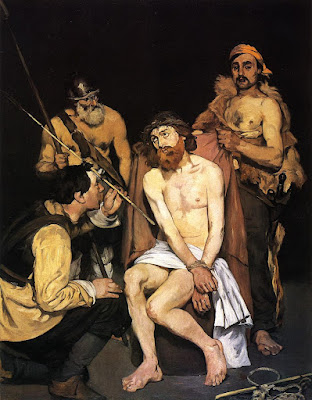 Title: The Deposition
Title: The DepositionArtist: Arnold Böcklin
Medium: Tempera and colored varnish on panel
Size: 160 x 250 cm
Date: c. 1874
Location: Nationalgalerie, Berlin.
19 IMAGES FROM THE 19th CENTURY: PART 13
John 19:38-40 And after these things Joseph of Arimathaea, who was a disciple of Jesus, but secretly through fear of the Jews, demanded of Pilate that he might take the body of Jesus: and Pilate allowed it. He came therefore and took away the body of Jesus. And Nicodemus also, who at first came to Jesus by night, came, bringing a mixture of myrrh and aloes, about a hundred pounds. They took therefore the body of Jesus and bound it up in linen with the spices, as it is the custom with the Jews to prepare for burial.
This painting demonstrates Böcklin's flair for archaization, one already employed by the Nazarenes, is seen in the Quattrocento coloring of this Deposition. A color palate consisting primarily of musty blues and greens, a deathly pallor covers the whole scene, as though the shade of Christ’s body is emanating and tinting the whole of the world. Part camp theatricality, part convinced and convincing Christianity, part prophecy, this canvas proved to be an Avant-Garde and unpopular work when first exhibited at the Vienna Exposition.
Arnold Böcklin (October 1827 –January 1901) was a Swiss symbolist painter. He was on of the major Swiss painter of the 19th century, and he exerted a great influence on the German-speaking countries through the expression of a heightened Romanticism and poeticism. He was trained in Germany, Flanders, and Paris, and spent seven years in Rome (1850-57), where he transformed his early naturalistic landscapes, more or less in the manner of Corot, into symbolic subjects with figures epitomizing the mood of the landscape. He was in Munich in 1871-74, in 1885 in Hottingen (Switzerland). However, like other German artists of the period, he spent much of rest of his life in Italy, where he died in Fiesole near Florence.




















